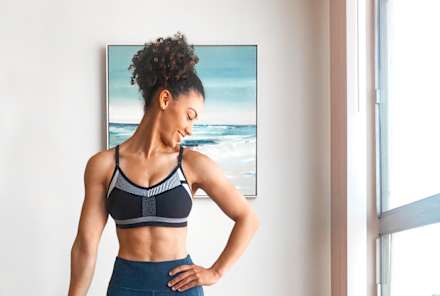Advertisement
This 5-Minute Core Workout Will Help You Build Your Strength ASAP

Ray Bass is the associate movement and wellness editor at mindbodygreen and a NASM-Certified Personal Trainer. She holds a degree in creative writing from the University of Pennsylvania, with honors in nonfiction.
There's no getting around it: Training your core can be a pain in the ass. It doesn't have to be—some people love it and center their workout around it—but more often than not it is, which is rather unfortunate. Our core, which consists of our diaphragm, deep abdominal muscles, and pelvic floor, is perhaps the most important part of our bodies when it comes to movement. Simply put, it controls everything we do.
So if you're someone who begrudgingly tacks core work onto the end of your workout, or you only do it when you "feel like it," this quick circuit might be your soul mate. You'll spend less time doing this circuit than you would standing in line for the bathroom. (The women's bathroom. Not the men's. Don't even get me started.)
But first—for those who need more of a reason to work on their core—a brief overview.
Why having a strong core is important.
"Our core stabilizes our axial skeletal, or our spine and pelvis," says Sarah Kostyukovsky, DPT. "When our appendages move (our arms and legs), we need to get the stability from our core to efficiently move our body in space. Without a good functioning core, our body is at more risk for injury and our body doesn't move as effectively, no matter what we do—whether that's walking, running, lifting, carrying, or exercising in general."
And as Jaime Schehr, N.D., R.D., notes, having a weak core can also lead to back pain (especially lower back pain), which an estimated 80% of adults experience at some point in their lives.
Now that we've covered the logic, here's the (expert-approved!) workout:
- 1 minute upright plank
- 1 minute side plank (30 seconds each side)
- 1 minute static boat pose
- 1 minute crunches (or crunch hold)
- 1 minute dead bug
This workout has five movements total, each done for 60 seconds with minimal rest in between. If you need to pause in between exercises, that's totally fine; the workout will just be a few minutes longer. If you can't complete the full 60 seconds, you can break each exercise up into two sets of 30 seconds, or shorten the overall exercise time to 45 seconds (and work your way up to a full minute!).
Upright Plank
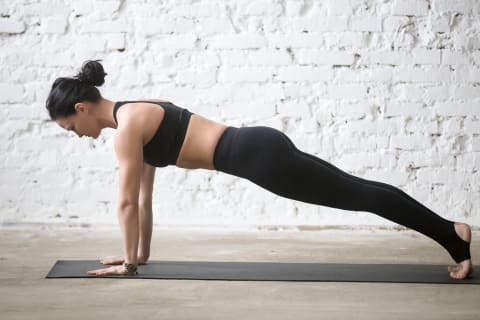
Assume a pushup position, making sure that your spine is neutral, your hips aren't piked up (no butts in the air), and your shoulders are stacked over your wrists. You want to maintain a straight line from head to heel. Focus on your breath, and hold for 60 seconds.
Side Plank
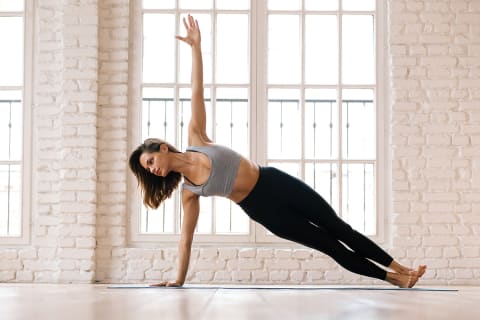
From your upright plank, rotate your body and re-center your weight while lifting one arm to the sky. Your body should be facing the side, and your chest should be open. Make a conscious effort to lift your hips up (it's easy to let them sag in this pose) and keep a straight line from head to heel. Then stack your feet on top of each other and hold. If you feel unstable with stacked feet, you can modify by staggering your feet. Hold for 30 seconds on each side.
Static Boat Pose
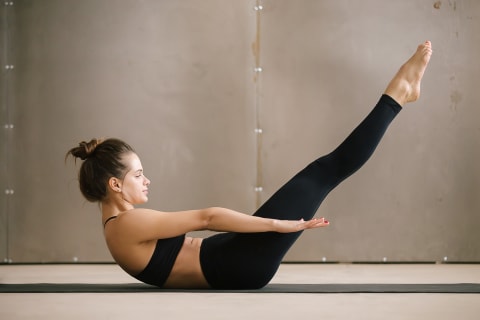
Next, lie down on your back to begin static boat pose. This is an isometric hold, meaning there's no repeated movement involved. Raise your legs up to a 45-degree angle, put your arms by your side, and then curl up like you would in a crunch, and hold. Ensure that your lower back is flat against the ground and you aren't tensing your neck or shoulders. To modify, bring your legs to tabletop position. Hold for 60 seconds or two sets of 30 seconds with a pause in between.
Crunches
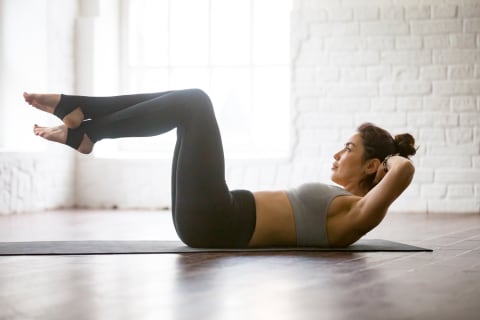
From static boat pose, bring your legs to tabletop and put your hands behind your head. Keeping your lower back pressed to the ground, curl your body up into a crunch and then lower yourself back down. Do this as many times as you can in a minute without sacrificing your form—aka err on the side of slow. Intention is more important than speed, and you don't want to strain your neck.
Dead Bug
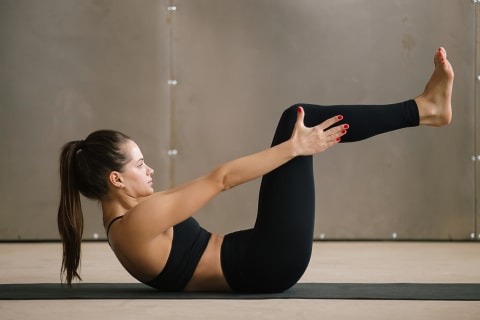
Finish your workout with a dead bug pose (yeah, strange name, we know). Start by lying flat on your back and bringing legs to tabletop with arms straight out in front of you. Relax your neck. Lower your right arm and left leg simultaneously (opposite arm and opposite leg) so that they're a few inches above the ground. From here, you have the option to return your arm and leg to starting position, switch which arm and leg you lower, and continuously alternate for a minute, or you can do a static hold on one side for 30 seconds and switch.
This tends to be one of the more difficult core exercises, but there are several ways to modify it. The first is to keep your arms still in front of you and just alternate lowering each leg from tabletop. Alternatively, you can place your legs in tabletop, crunch up, keeping your arms straight, similar to what you'd do in boat pose, and lower one leg at a time.
So, is it safe to train your core every day?
Like any other muscle, building a strong core takes time. And with this workout only taking five minutes, it's tempting (and easy) to overdo it in an effort to fast-track your core strength. Unfortunately, it doesn't work like that, and as you can imagine, that isn't the healthiest mindset to have.
"It isn't a good idea to train any body part repeatedly without recovery," Schehr says. "Doing so can increase your risk of injury. That said, because the core is such a large portion of the body, there are ways to train this area without repeating the same exercise or muscle daily."
Kostyukovsky agrees, adding, "Doing specific core exercises on a daily basis is safe and will make us stronger. If you are doing rectus abdominis and oblique muscle exercises to fatigue and you are sore the next day, I would give those muscles a rest from specific abdominal training. Pelvic floor, diaphragmatic breathing, and deep abdominal muscle exercises can be done daily."
Bottom line: Be consistent about training your core, but vary your exercises to target different sections of your core. And if you're training your core muscles to the point of intense fatigue and soreness, give yourself a break. Taking a day or two off won't set you back, and pain is no one's friend.
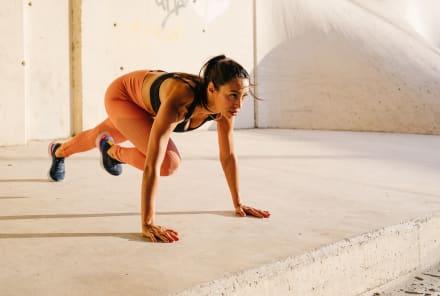
Short On Time? Try This Personal Trainer's 5-Minute Full-Body Workout
Krista Stryker, NSCA-CPT

Short On Time? Try This Personal Trainer's 5-Minute Full-Body Workout
Krista Stryker, NSCA-CPT

Short On Time? Try This Personal Trainer's 5-Minute Full-Body Workout
Krista Stryker, NSCA-CPT

Short On Time? Try This Personal Trainer's 5-Minute Full-Body Workout
Krista Stryker, NSCA-CPT



